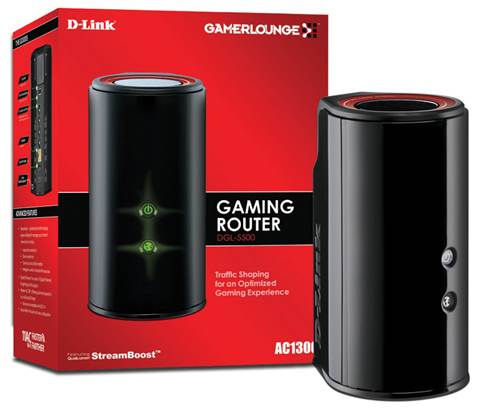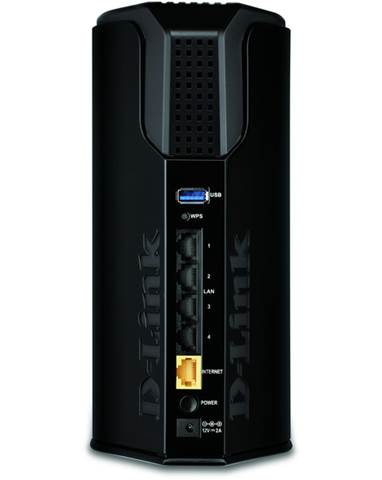A router built specifically
for gamers
When it comes to PC parts and accessories, all roads
eventually lead to gamers. Intel and AMD both sell unlocked processors so
gamers can more easily overclock their rigs for a few extra frames per second;
pro gamer Johnathan “Fatal1ty" Wendel has endorsed everything from
motherboards to power supplies; there’s gaming RAM; and of course, a whole
assortment of accessories designed to give you an edge when smoking your
friends on the virtual battlefield. Up until now, one of the few items missing
from the list was an 802.11ac wireless router.
D-Link gets credit for tying up that loose end with the
DGL-5500, a dual-band AC1300 wireless router built specifically for gamers.
What makes the DGL-5500 different from all the other 802.11ac models, including
D-Link's own DIR-868L (reviewed in our February issue), is the inclusion of
Qualcomm’s StreamBoost technology.

D-Link DGL-5500 with box
Whereas the majority of modern routers rely on simple
quality of service (QoS) rules to prioritize network packets, StreamBoost
examines what applications are running and how much actual bandwidth each one
needs. It also manages latency because a laggy gamer is a dead gamer. The
question is, does it work as advertised?
For the most part, StreamBoost lives up to the hype. We
consistently saw lower pings in online games when connected to the DGL-5500
versus our zero-point router, the Asus RT-AC66U. External factors beyond our
control also affect ping, so it's hard to offer an apples-to-apples comparison,
but to give one example, our ping averaged around 42ms in Battlefield U when
using Asus's router. When switching to D-Link’s model and turning on
StreamBoost, our pings hovered around 19ms. After firing up Netflix on a second
PC and initiating file downloads on two other systems, the ping stayed around
22-24ms - that's impressive.

D-Link DGL-5500’s front
In our evaluation of D-Link's DIR-868L, we said the fugly
web-based interface could use a major overhaul, and that's wha t we got with
the DGL-5500. It’s much better looking than before and far less complicated to
navigate, though it’s also painfully slow when switching between menus. The Ul
is also heavily biased toward StreamBoost - if you disable the feature, you
lose access to the My Network map, which provides a graphical view of all
active devices and how much bandwidth each one is consuming.
The DGL-5500 outpaced our zero point router in 802.11 n mode
on the 2.4GHz band in our three indoor tests. It also did better at picking out
uncluttered channels on its own - we use inSSIDer ($20) to identify the best
channells) for testing. However, the RT-AC66U boasts better range and faster
transfers in 802.11ac mode on the 5GHz band. It's worth pointing out the
DGL-5500 lacks beamforming, which concentrates the wireless signal at connected
devices for longer range and better speeds.

D-Link DGL-5500’s back
There are other shortcomings, as well - you can't configure
Guest networks, the single USB 2.0 port doesn't support printer sharing, and
the combined speed of both channels is capped at AC1300 rather than AC1750 as
it is with D-Link's DIR-868L. While StreamBoost is a step forward, the router
is a step backward in other areas. Note to D-Link: Gamers care about this stuff,
too.
|
Specifications
·
Price: $140
·
Type: Wireless router
·
Standards: IEEE 802.11ac (draft); IEEE 802.11g; IEEE 802.11n;
IEEE 802.11a; IEEE 802.3; IEEE 802.3u; IEEE 802.3ab
·
Interfaces: 4 Gigabit LAN Ethernet Ports (10/100/1000) ; 1
Gigabit WAN Ethernet Port (10/100/1000) ; 1 USB 2.0 Port
·
Security: Wi-Fi Protected Access (WPA/WPA2); WPS
·
LEDs: Power; Internet
·
Power: DC 12V
·
Certifications: FCC; IC; Wi-Fi
·
Dimensions: 9.8 x 6.5 x 2.8 inch
·
Warranty: 2-Year Limited Warranty
Verdict
·
Pros: Lowers latency when gaming; fast speeds at close range.
·
Cons: No printer sharing; can’t configure Guest networks; lacks
beam-forming.
·
Rating: 7/10
|